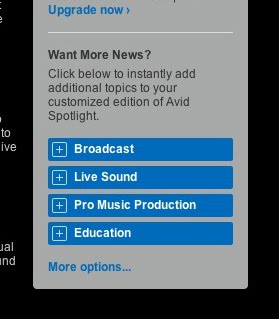 Hi everyone. Between taking a nice vacation, recovering from the vacation and then work travel, the ‘old blog was collecting some dust. During my travels and discussions with customers, one of the items that keeps coming up is the need for clean, complete and accurate data. When you have the right data you can laser focus your marketing efforts and achieve a higher response from your marketing campaigns. This hopefully results in more sales opportunities and closed business for your company and that nice bonus that you deserve.
Hi everyone. Between taking a nice vacation, recovering from the vacation and then work travel, the ‘old blog was collecting some dust. During my travels and discussions with customers, one of the items that keeps coming up is the need for clean, complete and accurate data. When you have the right data you can laser focus your marketing efforts and achieve a higher response from your marketing campaigns. This hopefully results in more sales opportunities and closed business for your company and that nice bonus that you deserve.Let’s face it, there is no magic wand that will instantly get you the data that you need for your segmentation goals. It’s going to take some time and effort but there are some ways to automate the process and I’m going to focus on two examples that I came across this week. Before we get to these, let’s examine the pitfalls that some marketers fall into when it comes to collecting data.
Reality Bites: We’re Too Busy, We Change and We Lie
One of the easiest ways to build out the profile of individuals in your database is to ask people to provide you with the information you need for your segmentation purposes and to make sales happy. This is typically done when visitors arrive on a landing page where they are encouraged to fill out a form to receive something in return (demo, white paper, webinar etc…). At times, you may see a really long form that asks for everything from your name to the name of your pet (Ok, maybe not the name of your pet but you know what I mean). Here are the problems with this approach:
-
If you ask for too much information, your form conversion rate will go down. The more fields you have on a form that is designed to generate leads, the greater the chance that a web visitor will not the complete the process. The reality is that buyers typically need the information you’re offering but can be impatient and feel that if there is too much effort for a simple piece of content, it’s just not worth it and move on.
- People lie. Don’t tell me you’ve never entered in a fake name and phone number to download something. You really need to consider the information that you ask people and when in the buying process you are asking for it. Requesting web visitors for the time frame in which they are looking to buy your product can be problematic as the person completing the form may lie to avoid getting a call from a sales rep even if they are looking to purchase in the next 3 months.
- Seasons change. People change. The interests and position you have today may not be the same three months down the road. Are you allowing people to update their information?
You’re probably saying “well, I need that data to properly segment and route potential leads so I have no other choice but to have those really long forms and ask for everything up front”. There are other ways to collect the information you need but it involves being patient and having the right tools. When creating a lead gen form remember to focus on collecting data that you need at that point in time and to ensure that there is a true value exchange of information. Therefore, while it may be okay to ask for the complete address of a registrant when they sign up to receive your newsletter, you need to ask yourself: Do I really need to collect this information now? Is it justified for me to ask for this information for what the web visitor will be receiving in return? Remember to keep the subscriber in mind as your work through your data collection processes. Let’s get to some possible ideas that will help you improve the way that you collect information from your subscribers.
Example 1: Dynamic Email Content Based on Email Clicks
When asking an email subscriber to provide any of their private information, it’s best to do so in a way that makes it as easy as possible for the subscriber and is as unobtrusive as possible. I recommend a method called “Progressive Profiling” in which you collect information from the subscriber over time. For example, if you’ve entered a new subscriber into a lead nurturing program you can ask for additional bits of info such as their title, major challenge or geographic location as they download pieces of content from the emails that are part of this program. This subtle approach works well and has produced high conversion rates (I need to dedicate a post just on this topic).
This past week, I read about a fantastic approach from Avid that makes it easy for email subscribers to customize the email content they receive from Avid as well as let Avid know what they are interested in. The other bonus for Avid is that they don’t need to send different versions of the newsletter – they just send one version that dynamically changes the content based on the subscribers preferences. Just by clicking on a button in the email, the subscriber will receive an updated email newsletter with content that is tailored to their needs. Avid now has additional data they can use to send more targeted communications and their approach could not have been easier for the subscriber.
How did Avid do this? You can get your “geek on” read the full details but I’ll provide you with the Coles notes version. On the initial email newsletter you receive when you provide your email address, you are encouraged to customize future newsletters by selecting the topics that most interest you. When a topic is clicked on, the registrants profile is updated through the magic of marketing automation and can be used to determine which content should appear when the next newsletter is sent. You can try this out yourself here: http://forms.avid.com/forms/spotlightdemo

Let’s move on the second example from SmartBrief that can help you get your subscribers to update their information.
Example 2: Optional Profile Update When You Clickthrough from Email
As a manager I’m always looking for tips on improving my leadership skills and one newsletter that I read consistently is by SmartBrief (which I highly recommend). While SmartBrief does ask for a fair amount of information up front, subscribers get tremendous value in the content and it’s worth it. Last week I had a unique experience when I clicked on an article from an email they sent me. Before I was taken to the article, I came to a screen that gave me the option of updating my profile or going right to the article:
While I don’t know how successful this approach was for SmartBrief, I thought it was innovative and shouldn’t be too difficult for marketers to replicate (ping me if you want to discuss how to do this in more depth). When I clicked on the “Update My Profile” button, all of my information was pre-populated which made it easy for me to scan it to see if any updates were needed. I also liked how I was thanked for being a loyal newsletter subscriber as well as provided with an offer of the 10 most popular stories from the past year if I chose to update my profile. I found this approach unique as I didn’t find this method too intrusive. I would recommend that marketers experiment with this tactic if they’re looking for a way to get subscribers to update their profile.
Both examples demonstrate how you can collect additional data for segmentation purposes in an easy and non-threatening approach. Hopefully this will spark some ideas of your own and you can work on improving how you get a more complete and accurate view of your database to assist you in your marketing efforts. Good luck!
Until next time.
Chad H.
